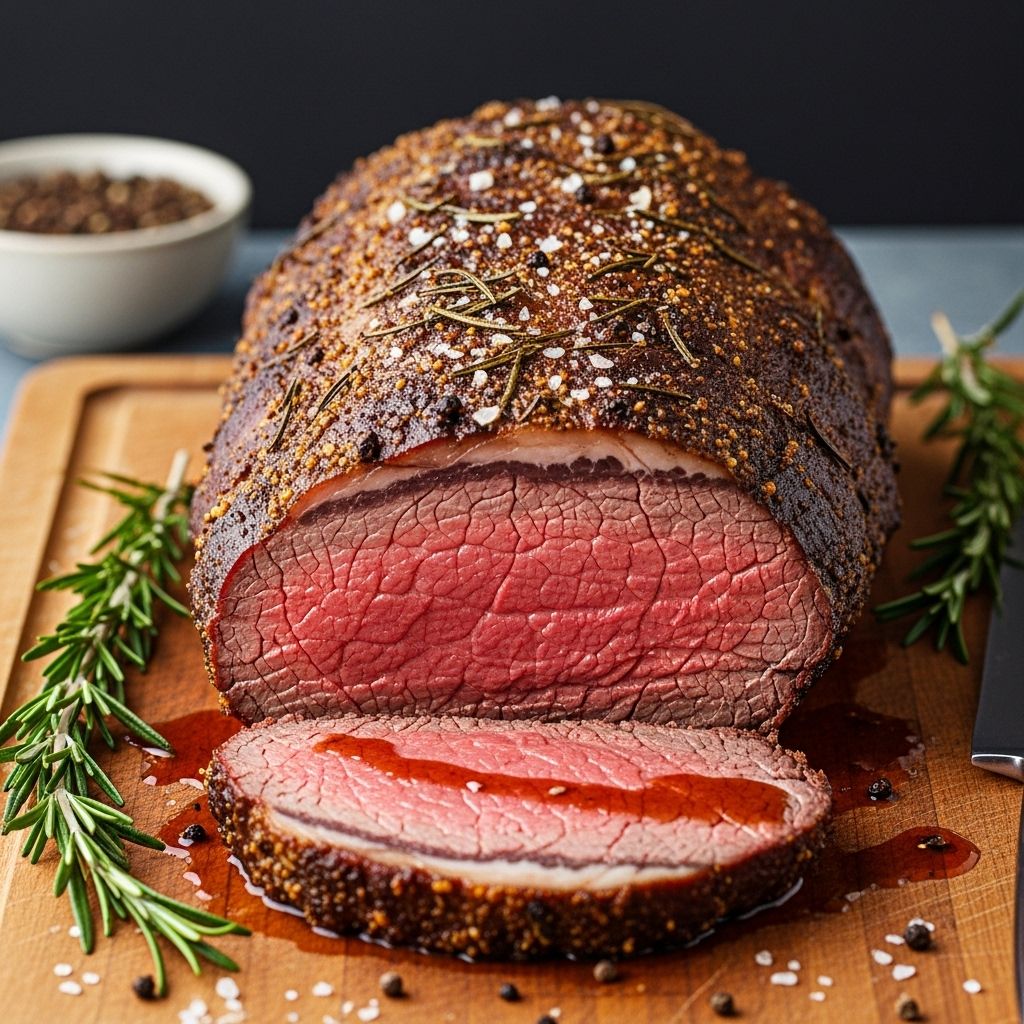The Ultimate Guide to Slow-Roasted Beef Tenderloin: A Holiday Showstopper
Get reliably tender, juicy results with a simple, flexible cooking schedule.

Slow-Roasted Beef Tenderloin: The Centerpiece of Celebration
Few dishes say “special occasion” like a slow-roasted, reverse-seared beef tenderloin. Renowned for its melt-in-your-mouth tenderness, rich flavor, and dramatic presentation, this recipe is a perennial favorite for holiday gatherings, dinner parties, and milestone events. Inspired by culinary authority J. Kenji López-Alt’s methodology, it guarantees juicy, rosy meat from edge to edge with a deeply caramelized crust—making your celebration memorable and your cooking stress-free.
Why Choose the Slow-Roast Reverse-Sear Method?
- Edge-to-Edge Doneness: Cooking at a low temperature allows heat to gently penetrate the meat, resulting in a consistent doneness throughout the roast.
- Juicy and Tender: Slow-roasting preserves moisture and tenderness, minimizing risk of overcooking.
- Unbeatable Crust: A final high-heat sear delivers an evenly browned, flavorful exterior.
- Stress Reduction: Flexible timing and forgiving process let you prepare ahead and finish just before serving.
Ingredients for Slow-Roasted Beef Tenderloin
- 2–3 lb center-cut beef tenderloin, trimmed and tied
- Kosher salt
- Freshly ground black pepper
- 4 tbsp unsalted butter
- 4 sprigs rosemary or thyme (or 2 each for a mixed aromatic profile)
- 1 shallot, roughly sliced
- Optional: Chives and a classic horseradish cream sauce for serving
These ingredients combine to amplify the beef’s natural flavors while building aromatic complexity through herbs and alliums, with a creamy, zippy sauce as an optional complement .
Step-by-Step Guide: Preparing and Cooking Beef Tenderloin
1. Trimming and Tying the Tenderloin
Ask your butcher for a center-cut tenderloin, or perform this yourself: remove silver skin and excess fat, and tie the roast with kitchen twine at 1-inch intervals to promote even cooking and maintain shape.
2. Seasoning
Generously salt the tenderloin hours (or even a day) ahead to enhance flavor and tenderize the meat. When ready to cook, season with black pepper.
3. Slow-Roasting
- Preheat oven to 225°F (107°C). This gentle heat prevents overcooking and produces the iconic ‘edge-to-edge’ doneness.
- Rack Setup: Place tenderloin on a wire rack set over a rimmed baking sheet for optimal hot air circulation.
- Add butter, herbs, and shallot to the pan: these aromatics infuse subtle flavor.
- Roast until internal temperature reaches 120°F (49°C) for rare or 125°F (52°C) for medium-rare (about 1–2 hours, depending on size).
4. Resting
Cover with foil and rest for 30 minutes to 1 hour. This crucial step allows juices to redistribute, keeping the meat moist.
5. Reverse-Searing
- Preheat a cast-iron pan over high heat or prepare a gas grill.
- Add more butter or oil. Sear roast on all sides until a deep brown crust forms (about 2–3 minutes per side).
This quick finish brings irresistible texture and flavor without risking overdone meat.
6. Slicing and Serving
Slice into thick rounds, garnish with chives, and serve with horseradish cream sauce or your favorite accompaniments.
Expert Tips for Perfect Beef Tenderloin
- Season Ahead: Salting early creates a deeper flavor and promotes juiciness.
- Don’t Skip the Rest: Resting is as crucial as roasting for tender results.
- Use a Thermometer: Precision is key—invest in a reliable digital probe to monitor doneness.
- Reverse-Sear: Searing after slow-roasting ensures the crust without sacrificing the interior.
- Don’t overcrowd the pan: Ample space in the oven and during searing ensures even cooking.
Suggested Sides and Sauces
- Horseradish Cream Sauce: The peppery kick and tang pair beautifully with rich beef.
- Roasted Vegetables: Carrots, potatoes, and asparagus echo the meal’s festive vibe.
- Red Wine Reduction: Adds complexity and ties the meal together.
Common Mistakes to Avoid
- Skipping the Thermometer: Guesswork leads to dry or undercooked beef.
- Insufficient Rest: Carving too soon causes juices to run out, resulting in dryness.
- Searing Too Long: Over-searing may overcook edges or burn aromatics.
- Poor Trimming: Leaving excess fat/silver skin hampers tenderness.
Nutritional Overview & Table
| Serving | Calories | Protein (g) | Fat (g) | Carbs (g) |
|---|---|---|---|---|
| 4 oz beef tenderloin | 180 | 24 | 8 | 0 |
| Horseradish sauce (2 tbsp) | 40 | 0.5 | 3.5 | 2 |
Beef tenderloin is naturally high in protein and relatively low in fat compared to other cuts, making it indulgent but balanced.
Frequently Asked Questions (FAQs)
Q: What is reverse-searing, and why is it used?
A: Reverse-searing is a technique where meat is first cooked gently at low temperature, then finished with a high-heat sear. This method ensures even doneness and a perfect crust .
Q: Can I prepare beef tenderloin ahead of time?
A: Yes! Slow-roast, then allow to rest. Sear just before serving for the freshest crust and warm center.
Q: How do I know when the meat is done?
A: Use a digital thermometer: 120°F for rare, 125°F for medium-rare. Pull from oven and allow to rest as ambient heat continues the cooking process.
Q: Is tenderloin suitable for all beef eaters?
A: Yes—its mild flavor and tenderness appeal to many. Pairing with bold sauces allows customization for various palates.
Q: What’s the best way to slice and serve?
A: Use a sharp carving knife. Slice into thick steaks or medallions, garnish, and serve immediately.
Serving Suggestions & Presentation
- Family-style Platter: Arrange slices on a warmed platter, sprinkle with fresh chives, and surround with roasted veggies.
- Individual Plates: Pair tenderloin slices with sauce and sides for refined plating.
Garnishing with roasted shallots, herb sprigs, and colorful vegetables creates a festive visual impact—perfect for holiday tables.
Storing and Reheating Leftovers
- Refrigerate promptly: Store in airtight containers up to 3–4 days.
- Reheat gently: Use a low oven or sous-vide to maintain tenderness and avoid drying.
- Repurpose: Turn leftovers into steak sandwiches, salads, or wraps for a gourmet lunch.
Holiday Hosting Tips
- Plan ahead: Complete trimming, seasoning, and prepping early in the day.
- Set up sides and sauces: Prepare accompaniments before guests arrive.
- Impress with plating: Warm serving platters and coordinate colors for maximum appeal.
Conclusion: The Art of Slow-Roasted Beef Tenderloin
Mastering the slow-roasted, reverse-seared beef tenderloin elevates your culinary repertoire, impresses guests, and anchors festive meals. With a few simple steps and expert guidance, you’ll enjoy consistently perfect, tender, and flavorful results—making every celebration memorable.
References
Read full bio of Srija Burman












